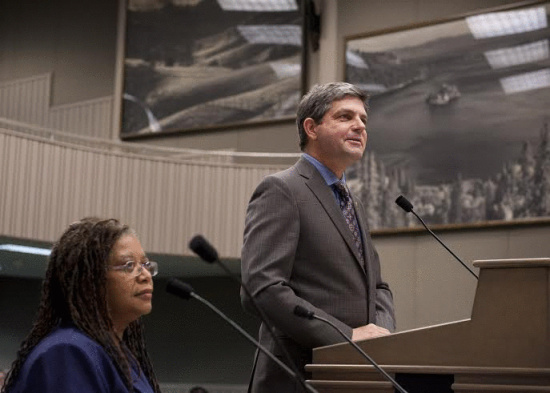Stewart, Wood testify at the Assembly Transportation Committee yesterday. Photo: Assm. Wood’s office.
Humboldt County is still pretty freaked out by the recent back-to-back fiber optic outages late last year, and it seems that our legislators are feeling that pain.
Earlier this week, Assm. Jim Wood’s “Broadband Map Act” — AB 1549 — got its first committee hearing. The bill, as written, would require the California Department of Transportation to keep maps of all fiber-optic lines in the state, and it has two purposes: To help avert the construction-related whoopsie-daisies like the one that took everyone offline for 20 hours or so last month, and to have a ready map of existing infrastructure available for those who would like to expand broadband services to more rural, underserved areas of the state.
Here it should be noted that the local Caltrans office vehemently denies — aggressively denies, even — that it was at fault for the most recent fiber-optic cut, even though its own backhoe did the cutting. Whoever buried the line in the first place buried it too shallow, Caltrans contends.
But a map couldn’t hurt, and people like Connie Stewart — the executive director of the California Center for Rural Policy in Arcata — think it could help their own efforts to expand rural broadband quite a bit. No one has an accurate, complete map of California’s fiber optic lines, which means that it’s more difficult than it should be to figure out how to connect rural communities up to the grid.
The Assembly’s Transportation Committee, which received the testimony of Stewart and others on Monday, had a bit of a critical take on the legislation, initially. Does having a public map of the state’s fiber optic lines open them up even more to saboteurs? Would it be reasonable or cost-effective for Caltrans to track all the state’s fiber optic infrastructure, even the bits of it that aren’t already within its own sphere of influence?
But the committee report notes that Wood seems open to altering his bill to require Caltrans only to map those bits of the fiber-optic network that follow its own rights-of-way. And Paul Ramey, the communications officer in Wood’s Sacramento office, told the Outpost last night that they are working on developing procedures for limiting access to the map to those people with an actual need for the information.
Press release from the office of Assm. Jim Wood:
Assemblyman Jim Wood’s Broadband Map Act, AB 1549, passed its first major hurdle in the Assembly Transportation Committee [earlier this week]. There to testify on behalf of the bill was California Center for Rural Policy Executive Director Connie Stewart.
Assemblyman Wood said, “In 2016 there are still too many Californians that do not have access to high speed internet, or reliable telecommunications. As Chair of the Select Committee on the Digital Divide in Rural California it is my intention to do everything possible to ensure our rural communities have access to a dependable digital infrastructure.”
AB 1549 would require Cal-Trans to keep a centralized database of where conduits available for fiber-optic cables are laid throughout the state. Currently, data regarding the location of fiber lines is scattered among dozens of companies and agencies. Developing a comprehensive map of which areas have broadband access, and which do not is next to impossible. The development of a central database would drastically reduce the cost and time it takes to further expand California’s broadband network.
Ms. Stewart said, “This is an important step towards closing the digital divide in Rural California. Allowing providers to know where Caltrans has conduits will save millions of dollars in deploying fiber cables throughout California.”
The absence of critical mapping data has created serious telecommunication outages throughout California. On December 9th 2015 Caltrans workers, not knowing a cable existed, severed an AT&T fiber-optic cable, wiping out services to tens of thousands of North Coast Residents for nearly 24 hours.
“This outage could have been prevented”, said Wood. “AB1549 is a relatively simple solution that will lead to fewer outages, and make it less expensive to deliver high speed internet to communities that currently don’t have that access”, said Wood. “This database would be huge for our rural communities who are trying to compete in the 21st Century.”
AB 1549 will next be heard in the Assembly Appropriations Committee.
###
PREVIOUSLY
- THE INTERNET IS DOWN!!! Massive AT&T Outage Takes Humboldt County Phones, Internet, Etc. Offline
- Beyond Redundancy: Why Last Month’s AT&T Outage Sucked So Bad
- (UPDATE) COMMUNICATION BREAKDOWN: AT&T Internet/Phone Service Outages Reported in Humboldt
- AT&T Says: Yes, Our New North Coast ‘Network Upgrade’ Will Include Emergency Access to East-West Fiber

CLICK TO MANAGE